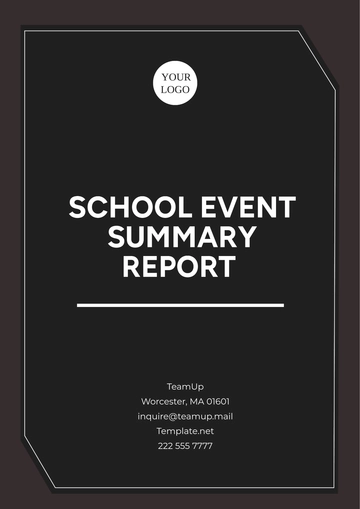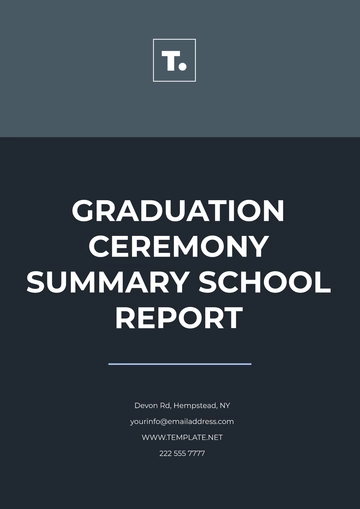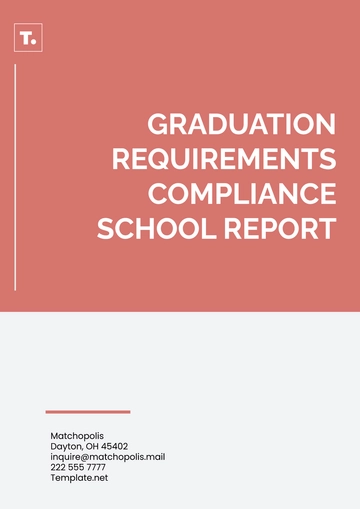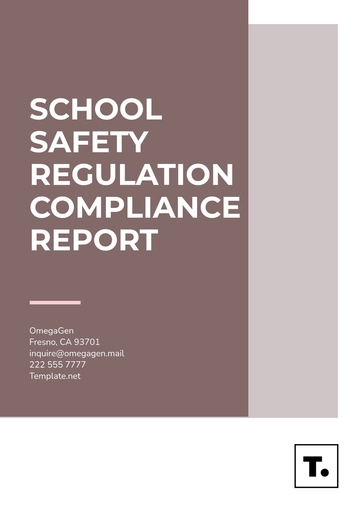Free School Annual Report

I. Introduction
Welcome to the 2050 Annual Report for [Your Company Name]. This report provides comprehensive insights into the key achievements, financial health, academic performance, extracurricular activities, and strategic direction of our school for the year 2050. It highlights our successes, addresses challenges, and outlines our future plans to continue enhancing the educational experience for our students and community.
II. Executive Summary
In 2050, [Your Company Name] has made significant strides in improving educational outcomes, expanding our facilities, and strengthening community ties. This section provides a comprehensive summary of our key achievements and challenges over the past year, highlighting our commitment to providing a top-tier educational experience for our students.
A. Key Achievements
Improved Student Performance in Standardized Tests
Our students achieved higher scores in standardized tests, reflecting the effectiveness of our teaching methodologies and curriculum enhancements. The average scores improved across all grade levels, with notable increases in math and science proficiency. This success is attributed to the following initiatives:
Curriculum Enhancements: Implemented a revised curriculum focusing on critical thinking, problem-solving, and real-world applications.
Teacher Training: Provided professional development opportunities for teachers to adopt innovative teaching strategies and integrate technology into their lessons.
Tutoring Programs: Expanded after-school tutoring programs to offer additional support to students struggling in specific subjects.
Inauguration of a New Science and Technology Building
The new facility provides state-of-the-art laboratories and learning spaces, fostering innovation and hands-on learning experiences in STEM fields. The building includes:
Advanced Laboratories: Equipped with modern equipment for biology, chemistry, physics, and technology courses.
Innovation Hubs: Dedicated spaces for students to work on science projects, robotics, and coding.
Collaboration Zones: Areas designed for group work and interdisciplinary projects, encouraging collaborative learning.
Expansion of Extracurricular Programs
We introduced new sports teams, clubs, and societies, offering students a broader range of activities to develop their skills and interests outside the classroom. These programs play a crucial role in holistic student development, providing opportunities for leadership, teamwork, and personal growth. Highlights include:
New Sports Teams: Added lacrosse, swimming, and track and field teams, increasing student participation in athletics.
Cultural Clubs: Established clubs for art, drama, and music, allowing students to explore their creative talents.
Academic Societies: Formed new societies focused on debate, robotics, and environmental science, fostering intellectual engagement and community involvement.
Partnerships with Local Businesses and Organizations
We established new collaborations with local businesses and community organizations to enhance our students' learning experiences and career readiness. These partnerships provided:
Internship Opportunities: Students gained real-world experience through internships with local companies.
Guest Lectures: Professionals from various fields shared their expertise and career insights with students.
Community Projects: Collaborative projects with local organizations allowed students to apply their learning in meaningful ways, such as environmental clean-ups and social service initiatives.
B. Challenges
Adapting to New Educational Technologies
Integrating new technologies into our curriculum posed challenges, requiring significant investment in training and infrastructure. While these technologies have the potential to enhance learning, their effective implementation depends on:
Teacher Training: Ensuring all teachers are proficient in using new educational tools and software.
Infrastructure Upgrades: Upgrading our IT infrastructure to support advanced digital learning platforms.
Student Accessibility: Providing resources to ensure all students have access to necessary technology, both in school and at home.
Funding Constraints for Special Programs
Securing sufficient funding for special programs and initiatives remained a challenge, impacting our ability to expand certain services and resources. Key areas affected included:
Special Education: Limited funding restricted the expansion of resources for students with special needs.
Extracurricular Activities: Some planned activities and clubs could not be launched due to budget constraints.
Facility Maintenance: Delayed maintenance projects on older buildings due to prioritizing funds for new construction and technology upgrades.
III. Financial Overview
The financial health of [Your Company Name] remains strong. This overview provides a detailed snapshot of our financial performance for the year ending December 31, 2050.
A. Revenue and Expenditures
Category | Amount |
|---|---|
Total Revenue | $10,000,000 |
Total Expenditures | $9,500,000 |
B. Funding Sources
Source | Amount |
|---|---|
Tuition Fees | $7,000,000 |
Grants and Donations | $2,000,000 |
Government Funding | $1,000,000 |
C. Financial Highlights
Revenue Growth
Total revenue increased by 8% compared to the previous year, driven by higher enrollment rates and successful fundraising campaigns. Key factors contributing to this growth include:
Increased Enrollment: Enhanced marketing and outreach efforts led to a significant increase in student enrollment.
Successful Fundraising: Organized several successful fundraising events, including gala dinners and online crowdfunding campaigns.
Grants and Donations: Received substantial grants from educational foundations and increased donations from alumni and community supporters.
Expenditure Management
Despite increased spending on new facilities and programs, effective budget management ensured that total expenditures remained within the projected limits. Strategies implemented to manage expenditures included:
Cost-Saving Measures: Negotiated better rates with suppliers and reduced operational costs through energy-saving initiatives.
Prioritizing Investments: Focused spending on high-impact areas such as technology upgrades and facility improvements.
Budget Monitoring: Regularly reviewed financial performance and adjusted budgets as needed to avoid overspending.
Surplus Allocation
The surplus revenue was allocated towards building reserves for future projects and unforeseen expenses, ensuring financial stability and sustainability. Specific allocations included:
Future Projects: Set aside funds for upcoming construction projects and major renovations.
Emergency Reserves: Established a reserve fund to cover unexpected costs and emergencies.
Program Expansion: Allocated additional funds to expand successful programs and initiatives, such as STEM education and special education services.
IV. Academic Performance
Our students have demonstrated outstanding academic performance in various assessments during the year. This section highlights their achievements and the programs that support their academic success.
A. Standardized Test Scores
Grade Level | Average Score |
|---|---|
Grade 1 | 85% |
Grade 2 | 88% |
Grade 3 | 90% |
The improved scores across all grade levels are a testament to the effectiveness of our educational programs and the dedication of our teachers. Initiatives that contributed to these results include:
Enhanced Curriculum: Updated curriculum with a focus on critical thinking and problem-solving skills.
Teacher Development: Regular professional development sessions to equip teachers with innovative teaching strategies.
Student Support: Additional support programs such as tutoring and mentoring for students needing extra help.
B. Graduation Rate
We are proud to report a graduation rate of 98% for the class of 2050. This high graduation rate reflects our commitment to student success and the effectiveness of our academic support programs. Strategies that helped achieve this rate include:
Comprehensive Counseling: Providing personalized academic and career counseling to guide students through their high school journey.
Academic Interventions: Early identification and support for students at risk of falling behind, including tutoring and study skills workshops.
Extracurricular Engagement: Encouraging participation in extracurricular activities to foster a sense of belonging and motivation to succeed.
C. Academic Programs
Advanced Placement (AP) Courses
The number of students enrolling in AP courses increased by 15%, with a pass rate of 92%, demonstrating our students' readiness for college-level coursework. Enhancements to the AP program included:
Expanded Course Offerings: Introduced new AP courses in subjects such as computer science and environmental science.
Teacher Training: Invested in AP-specific training for teachers to help them deliver rigorous and engaging coursework.
Student Support: Offered preparatory workshops and study sessions to help students succeed in their AP exams.
Special Education
Our special education program expanded to include more resources and support staff, resulting in improved outcomes for students with special needs. Key improvements included:
Individualized Education Plans (IEPs): Developed personalized IEPs for each student, tailored to their unique needs and goals.
Additional Staff: Hired more special education teachers and aides to provide one-on-one support.
Resource Rooms: Created dedicated spaces equipped with specialized learning materials and technology.
STEM Initiatives
Participation in STEM programs grew significantly, with students excelling in science fairs and robotics competitions at both the regional and national levels. Enhancements to our STEM initiatives included:
New Labs and Equipment: Upgraded science labs with the latest technology and equipment.
Partnerships: Formed partnerships with local universities and tech companies to provide students with mentorship and internship opportunities.
Extracurricular Programs: Expanded after-school programs in robotics, coding, and engineering to foster a passion for STEM among students.
By focusing on these key areas, [Your Company Name] continues to provide a high-quality education that prepares students for success in college and their future careers.
V. Extracurricular Activities
Extracurricular activities are a vital part of our students' development, providing opportunities to explore interests, develop skills, and build community. This section highlights some of the key programs and events from the year.
A. Sports
State Champions in Basketball
Our basketball team clinched the state championship, demonstrating exceptional skill and teamwork. This achievement was the result of rigorous training, strategic planning, and a strong sense of camaraderie among team members. Highlights of the season include:
Regular Season Performance: The team had an impressive record, winning 85% of their games.
Tournament Success: They excelled in regional tournaments, securing a spot in the state finals.
Player Development: Several players were scouted for college basketball programs, reflecting their individual talents and the quality of our coaching staff.
Regional Champions in Soccer
The soccer team won the regional championship, showcasing their dedication and athletic prowess. Key factors in their success included:
Effective Coaching: Our coaching staff implemented advanced training techniques and game strategies.
Team Cohesion: Strong teamwork and communication on and off the field.
Community Support: Enthusiastic support from students, parents, and local community members.
New Sports Introduced
This year, we introduced new sports such as lacrosse and swimming, expanding the range of athletic opportunities available to students. These new programs were designed to cater to diverse interests and promote physical fitness. Highlights include:
Lacrosse Program: Attracted a large number of participants, with students quickly adapting to the new sport.
Swimming Team: Competed in regional meets and brought home several medals.
Increased Participation: The introduction of these sports led to a 20% increase in overall student participation in athletics.
B. Clubs and Societies
Debate Club
The Debate Club placed 1st in a national competition, reflecting their critical thinking and public speaking skills. Achievements include:
Debate Topics: Covered a wide range of subjects, enhancing students' knowledge and analytical abilities.
Mentorship: Students received coaching from experienced debaters and public speaking experts.
Recognition: Club members were invited to speak at various local events, showcasing their skills.
Robotics Club
The Robotics Club developed an award-winning project, highlighting their innovation and technical expertise. Notable achievements include:
Competition Success: Won first place in a regional robotics competition.
Innovative Projects: Developed robots for various applications, including a robot designed for environmental clean-up.
Skill Development: Members gained hands-on experience in programming, engineering, and teamwork.
Arts and Culture
Our arts and culture clubs, including the drama club and the school orchestra, hosted multiple performances and exhibitions, enriching the cultural life of the school. Key highlights include:
Drama Performances: Staged several successful plays and musicals, with high audience attendance and acclaim.
Orchestra Concerts: Performed at school events and local venues, showcasing the musical talents of our students.
Art Exhibitions: Held exhibitions featuring student artwork, promoting creativity and self-expression.
VI. Community Engagement
[Your Company Name] values its relationship with the community. We have initiated several programs to foster community engagement and support.
A. Community Service Projects
Annual Clean-up Drive
Students and staff participated in a community clean-up drive, promoting environmental stewardship. The event included:
Participation: Over 200 students and staff members volunteered.
Impact: Collected and properly disposed of over 500 pounds of trash.
Education: Included educational sessions on recycling and sustainability.
Free Tutoring Programs
We offered free tutoring services to local students, helping to bridge educational gaps and support academic achievement. Key aspects include:
Subjects Covered: Provided tutoring in math, science, and English.
Tutors: High-achieving students and faculty members volunteered as tutors.
Results: Improved academic performance for participating students, with many reporting better grades and increased confidence.
Fundraising for Local Charities
Various fundraising events were organized to support local charities, reinforcing our commitment to social responsibility. Highlights include:
Events: Hosted charity runs, bake sales, and silent auctions.
Funds Raised: Successfully raised over $20,000 for local charities.
Community Involvement: Engaged local businesses and community members in fundraising efforts.
B. Partnerships
Local Business Collaborations
Partnerships with local businesses provided students with internship opportunities, real-world experience, and mentorship programs. Key initiatives include:
Internships: Students gained valuable work experience in fields such as marketing, finance, and healthcare.
Guest Lectures: Business leaders were invited to speak at school events, sharing their insights and experiences.
Mentorship: Professionals from various industries mentored students, providing guidance and support for their career aspirations.
Non-Profit Organizations
Collaborations with non-profit organizations allowed us to expand our community service initiatives and offer more resources to students in need. Notable collaborations include:
Educational Workshops: Partnered with non-profits to offer workshops on topics such as financial literacy and mental health.
Resource Provision: Non-profits provided resources such as school supplies and meals to students in need.
Volunteer Opportunities: Students participated in volunteer activities organized by non-profits, gaining valuable experience and making a positive impact.
C. Community Events
Family Fun Day
A successful event that brought together students, families, and community members for a day of fun activities, fostering stronger community bonds. Highlights include:
Activities: Included games, food stalls, and live entertainment.
Attendance: Over 500 people attended the event.
Feedback: Received positive feedback from participants, with many expressing appreciation for the opportunity to connect with others in the community.
Cultural Festivals
We hosted cultural festivals celebrating the diverse backgrounds of our students, promoting inclusivity and mutual respect. Key aspects include:
Performances: Featured music, dance, and storytelling from various cultures.
Food Stalls: Offered a variety of foods representing different cultural traditions.
Workshops: Included workshops on cultural crafts and traditions, providing an educational experience for participants.
VII. Future Outlook
This section outlines [Your Company Name]'s strategic plans for the upcoming year and beyond. Our goal is to continue building on our successes and addressing challenges to ensure sustainable growth and improvement.
A. Expansion Plans
Construction of a New Library
A new library will be built to provide a modern, resource-rich environment for students and staff. Features will include:
Digital Resources: Access to a wide range of digital books and academic journals.
Study Spaces: Comfortable and well-equipped study areas for individual and group work.
Community Events: Space for hosting literary events, author talks, and reading programs.
Introduction of New Elective Courses
We plan to expand our curriculum with new elective courses in emerging fields such as artificial intelligence and environmental science. Benefits include:
Student Engagement: Increased interest and participation in these cutting-edge subjects.
Career Readiness: Equipping students with skills relevant to the future job market.
Innovation: Encouraging innovative thinking and problem-solving abilities.
Enhanced Digital Learning Platforms
Investments will be made in digital learning platforms to support blended and remote learning opportunities. Key initiatives include:
Learning Management System (LMS): Implementing a robust LMS to facilitate online coursework and resource sharing.
Virtual Classrooms: Providing tools for virtual classrooms and interactive learning experiences.
Technical Support: Ensuring students and staff have access to technical support and training for digital tools.
B. Strategic Goals
Increase Enrollment by 10%
Targeted marketing and outreach initiatives will be implemented to attract new students and families to our school. Strategies include:
Open Houses: Hosting open house events to showcase our facilities and programs.
Marketing Campaigns: Utilizing social media, local advertising, and community events to raise awareness.
Referral Programs: Implementing referral programs to encourage current families to recommend the school to others.
Launch a Teacher Training Program
A comprehensive professional development program will be introduced to enhance teachers' skills and knowledge. Key components include:
Workshops and Seminars: Regular training sessions on innovative teaching methods and curriculum development.
Peer Mentoring: Pairing new teachers with experienced mentors for guidance and support.
Continuous Education: Encouraging teachers to pursue advanced degrees and certifications.
Strengthen Alumni Network
Efforts will be made to engage alumni through networking events and mentorship programs, fostering a strong community connection. Initiatives include:
Alumni Events: Organizing reunions, networking events, and guest lectures featuring successful alumni.
Mentorship: Establishing mentorship programs where alumni can guide current students and recent graduates.
Alumni Portal: Creating an online portal for alumni to stay connected and access resources.
C. Innovation and Technology
Smart Classrooms
Implementation of smart classroom technologies to create an interactive and engaging learning environment. Features will include:
Interactive Whiteboards: Enabling dynamic teaching methods and student interaction.
Digital Devices: Providing tablets and laptops for students to use in the classroom.
Classroom Management Software: Facilitating efficient classroom management and student engagement.
Virtual Reality (VR) Learning
Introduction of VR learning tools to provide immersive educational experiences in subjects such as history and science. Benefits include:
Engagement: Increasing student engagement through interactive and immersive experiences.
Understanding: Enhancing understanding of complex concepts through visualization and simulation.
Innovation: Encouraging innovative thinking and exploration of new ideas.
D. Sustainability Initiatives
Green Building Practices
Incorporating sustainable building practices in new constructions and renovations to reduce our environmental footprint. Strategies include:
Energy-Efficient Materials: Using materials that reduce energy consumption and promote sustainability.
Green Roofs: Implementing green roofs to improve insulation and reduce urban heat island effects.
Water Conservation: Installing water-efficient fixtures and systems.
Energy Efficiency Programs
Implementation of energy efficiency programs to reduce utility costs and promote environmental responsibility. Initiatives include:
LED Lighting: Replacing traditional lighting with energy-efficient LED lights.
HVAC Upgrades: Upgrading HVAC systems to more efficient models.
Energy Audits: Conducting regular energy audits to identify areas for improvement.
By focusing on these strategic goals and initiatives, [Your Company Name] is committed to continuing its tradition of excellence and providing an outstanding educational experience for all students. We look forward to the opportunities and challenges of the coming year, confident in our ability to achieve our objectives and support the growth and development of our students and community.
VIII. Contact Information
For more information, please contact [Your Name] at [Your Email]. You can also visit our website at [Your Company Website] or follow us on social media [Your Company Social Media].
IX. Acknowledgements
We extend our deepest gratitude to the students, parents, staff, and community partners who have contributed to our success this year. Your support and dedication have been instrumental in achieving our goals and ensuring a bright future for [Your Company Name].
[Your Company Name] looks forward to another year of growth and achievement, building on the strong foundation we have established. Together, we will continue to create an enriching educational environment that fosters academic excellence, personal growth, and community engagement.
- 100% Customizable, free editor
- Access 1 Million+ Templates, photo’s & graphics
- Download or share as a template
- Click and replace photos, graphics, text, backgrounds
- Resize, crop, AI write & more
- Access advanced editor
Effortlessly compile comprehensive annual reports for your school with Template.net's School Annual Report Template. Tailored for educational institutions, this template streamlines the reporting process, ensuring clarity and professionalism. Fully editable and customizable with our AI editor tool, it empowers users to present key achievements, statistics, and insights in a visually engaging format.
You may also like
- Sales Report
- Daily Report
- Project Report
- Business Report
- Weekly Report
- Incident Report
- Annual Report
- Report Layout
- Report Design
- Progress Report
- Marketing Report
- Company Report
- Monthly Report
- Audit Report
- Status Report
- School Report
- Reports Hr
- Management Report
- Project Status Report
- Handover Report
- Health And Safety Report
- Restaurant Report
- Construction Report
- Research Report
- Evaluation Report
- Investigation Report
- Employee Report
- Advertising Report
- Weekly Status Report
- Project Management Report
- Finance Report
- Service Report
- Technical Report
- Meeting Report
- Quarterly Report
- Inspection Report
- Medical Report
- Test Report
- Summary Report
- Inventory Report
- Valuation Report
- Operations Report
- Payroll Report
- Training Report
- Job Report
- Case Report
- Performance Report
- Board Report
- Internal Audit Report
- Student Report
- Monthly Management Report
- Small Business Report
- Accident Report
- Call Center Report
- Activity Report
- IT and Software Report
- Internship Report
- Visit Report
- Product Report
- Book Report
- Property Report
- Recruitment Report
- University Report
- Event Report
- SEO Report
- Conference Report
- Narrative Report
- Nursing Home Report
- Preschool Report
- Call Report
- Customer Report
- Employee Incident Report
- Accomplishment Report
- Social Media Report
- Work From Home Report
- Security Report
- Damage Report
- Quality Report
- Internal Report
- Nurse Report
- Real Estate Report
- Hotel Report
- Equipment Report
- Credit Report
- Field Report
- Non Profit Report
- Maintenance Report
- News Report
- Survey Report
- Executive Report
- Law Firm Report
- Advertising Agency Report
- Interior Design Report
- Travel Agency Report
- Stock Report
- Salon Report
- Bug Report
- Workplace Report
- Action Report
- Investor Report
- Cleaning Services Report
- Consulting Report
- Freelancer Report
- Site Visit Report
- Trip Report
- Classroom Observation Report
- Vehicle Report
- Final Report
- Software Report





























